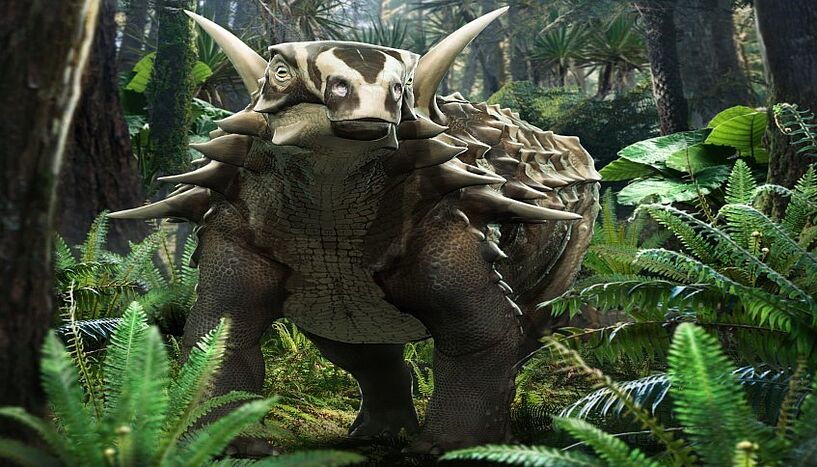Within a dinosaur’s head: ankylosaur was sluggish and deaf
11. January 2022
Life reconstruction of the dinosaur Struthiosaurus austriacus from the Late Cretaceous of Austria (© Fabrizio De Rossi)
Fossil braincase provides new surprising insights
German and Austrian scientists took a closer look at the braincase of a dinosaur from Austria. The group examined the fossil with a micro-CT and found surprising new details: it was sluggish and deaf. The respective study got recently published in the scientific journal scientific reports.
Ankylosaurs could grow up to eight meters in body length and represent a group of herbivorous dinosaurs, also called ‘living fortresses’: Their body was cluttered with bony plates and spikes. Some of their representatives, the ankylosaurids sometimes possessed a club tail, while nodosaurids had elongated spikes on their necks and shoulders. However, some aspects of their lifestyle are still puzzling.
While many dinosaurs likely lived in groups, at least some ankylosaurs seemed to prefer a lonesome life because of an inferior sense of hearing. That’s what the scientists from the universities of Greifswald and Vienna concluded when they examined the braincase of the Austrian dinosaur with a high-resolution computer tomograph to produce a digital three-dimensional cast.
Fossil braincases, which once housed the brain and other neurosensory tissues, are rare but important for science because these structures can provide insights into the lifestyle of a given animal. For example, the inner ears can hint to auditory capacities and skull orientation.
Struthiosaurus austriacus is a comparably small nodosaurid from the Late Cretaceous (80 Ma) of Austria and comes from a locality near Muthmannsdorf, south of Vienna. The fossil remains of this dinosaur already belonged to the collection of the Institute for Paleontology in Vienna in the 19th century. For their study, Marco Schade (University of Greifswald), Cathrin Pfaff (University of Vienna) and their colleagues examined the tiny (50 mm) braincase to reveal new details of the anatomy and lifestyle of Struthiosaurus austriacus. With these data, it was possible to learn more about its sense of equilibrium and audition.
The results of this study show that Struthiosaurus’ brain was very similar to the brains of its close relatives. For example, the flocculus, an evolutionary old part of the brain, was very small. The flocculus is important for the fixation of the eyes during motions of the head, neck and whole body, which can be very useful if such an animal was trying to target potential competitors or aggressors. "In contrast to its Northamerican relative Euoplocephalus, which had a tail club and a clear flocculus on the brain cast, Struthiosaurus austriacus may rather relied on its body armor for protection," says Marco Schade. Together with the form of the semicircular canals in the inner ear, this hints towards an exceptionally sluggish lifestyle of this Austrian plant eater. Furthermore, the scientists found the – so far – shortest lagena of a dinosaur. The lagena is the part of the inner ear where audition takes place and its size can help to infer auditory capacities. This study delivers new insights into the evolutionary history of dinosaurs and their world, in which Europe was largely submerged in the ocean.
Publication in Scientific Reports
Schade, M., Stumpf, S., Kriwet, J, Kettler, C., Pfaff, C. 2022. Neuroanatomy of the nodosaurid Struthiosaurus austriacus (Dinosauria: Thyreophora) supports potential ecological differentiations within Ankylosauria. Scientific Reports.
www.nature.com/articles/s41598-021-03599-9
DOI: doi.org/10.1038/s41598-021-03599-9
Scientific contact
Cathrin Pfaff
Institut für Paläontologie1090 - Wien, Althanstraße 14
+43-1-4277-535 21
cathrin.pfaff@univie.ac.at
Further inquiry
Mag. Alexandra Frey
Media Relations ManagerUniversität Wien
1010 - Wien, Universitätsring 1
+43-1-4277-17533
+43-664-8175675
alexandra.frey@univie.ac.at
Downloads:
Struthiosaurus_austriacus_848x484_C_Fabrizio_De_Rossi_01.jpg
File size: 137,96 KB
